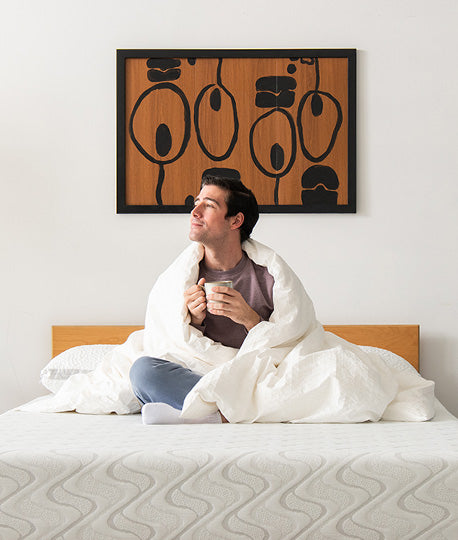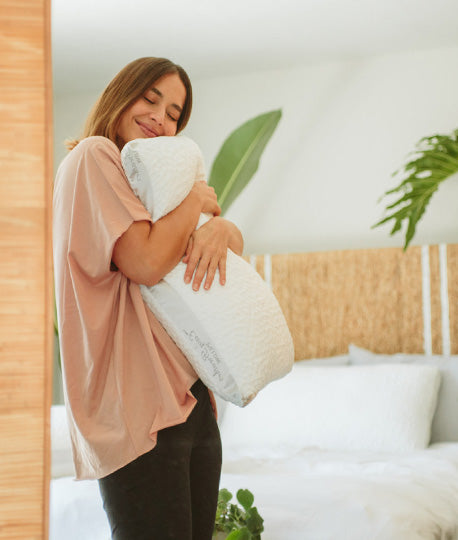Foam vs Down Pillows: Making the Right Choice for Better Sleep

Getting quality sleep begins with choosing the right pillow. One of the biggest decisions is deciding between foam and down. Both have their benefits and can affect your comfort, support, and overall sleep quality.
Down pillows offer a soft, luxurious feel that you can mold to your liking, while foam pillows provide targeted support with modern materials and design. The differences go beyond comfort and can influence spinal alignment, temperature regulation, durability, and even allergies.
Understanding Foam Pillows
Foam pillows have grown in popularity thanks to their supportive properties and advances in sleep science. Memory foam, the most common type, responds to pressure and body heat to create a personalized sleeping surface that keeps its shape all night.
Our Easy Breather Pillow shows the benefits of modern foam technology. The adjustable fill lets you set the height and firmness to match your preferences. The foam conforms to your head and neck while maintaining its structure, unlike traditional pillows that can flatten over time.
Foam pillows are especially good at relieving pressure, which helps side and back sleepers maintain proper spinal alignment. By distributing weight evenly, they reduce pressure points that can cause morning stiffness or discomfort.
Traditional memory foam can trap heat, so many modern foam pillows, including our Easy Breather collection, include cooling features and breathable covers. These improvements make foam pillows comfortable year-round, even for people who tend to sleep hot.
The Appeal of Down Pillows
Down pillows are a classic choice for luxury bedding, known for their exceptional softness and natural materials. Made from the soft undercoating of geese or ducks, genuine down creates a plush sleeping surface that many people love.
Down pillows also offer excellent temperature regulation. The natural filling traps air pockets to help maintain a comfortable temperature while staying breathable, making them suitable for all seasons. The material adapts to your movements during sleep, allowing you to adjust and mold the pillow as needed.
With proper care, down pillows often last longer than synthetic options, keeping their loft and comfort for several years. The natural resilience of down fibers helps them bounce back after compression, though occasional fluffing may be needed to maintain their shape.
Support and Sleeping Positions
Your sleeping position should play a big role in choosing the right pillow. Different positions need different levels of support to keep your spine properly aligned.
Side sleepers usually benefit most from foam pillows. The firm support helps keep the head, neck, and spine in line. Our Easy Breather Side Sleeper Pillow and Jr. Side Sleeper Pillow are designed with a curved shape that fits the shoulder while providing consistent support.
Back sleepers can be comfortable with either foam or down. Foam offers steady support to keep the head and neck aligned, while down can be shaped for the level of support you prefer. The goal is to maintain a neutral spine without pushing the head too far forward.
Stomach sleepers often prefer down pillows because they are soft and easy to mold. Minimal loft is important to prevent neck strain, and down pillows can be adjusted to lie flatter. Adjustable foam pillows also work well for stomach sleepers when you remove fill to reach the right height.
Durability and Maintenance
Foam and down pillows need different care to last their best. Foam pillows keep their shape without much fluffing, but they may need spot cleaning and occasional airing to stay fresh. Most foam pillows have removable, washable covers, making cleaning simple.
Down pillows need more frequent fluffing to maintain loft and prevent clumping. They can usually be machine washed if cared for properly, though professional cleaning may give the best results. Regular maintenance helps the down keep its shape and insulating properties.
The lifespan of both types depends on quality and care. High-quality foam pillows generally last two to three years, while premium down pillows can last five to ten years with proper upkeep.
Health and Allergies
For allergy sufferers, choosing between foam and down is especially important. Down pillows, while luxurious, may not be suitable for people with allergies to feathers or dust mites, which can build up in natural materials.
Foam pillows provide a hypoallergenic alternative, which is helpful for those with sensitivities. The dense foam resists dust mites and other common allergens, and our foam pillows include protective covers that boost their hypoallergenic properties.
Temperature Regulation
Temperature plays a big role in sleep quality. Down pillows naturally help regulate temperature by allowing air to circulate while providing insulation when needed. The structure of down creates small air pockets that keep your sleeping temperature comfortable.
Modern foam pillows have improved on past heat retention issues with smart design features. Our Easy Breather pillows include cooling technologies and breathable covers to help regulate temperature and prevent the heat buildup often seen with traditional memory foam.
Cost Considerations
Price often plays a role in choosing a pillow. High-quality down pillows typically cost more because of their natural materials and traditional craftsmanship, but the investment can pay off with a longer lifespan and lasting comfort.
Foam pillows generally cost less while still offering strong support and durability. Our foam pillows add extra value with adjustable fill, letting you customize the height and firmness as your needs or preferences change.
Making Your Choice
Choosing between foam and down pillows means thinking about several factors:
-
Your sleeping position and support needs
-
Temperature preferences
-
Allergy concerns
-
How much maintenance you are willing to do
-
Budget
Start by looking at your main sleep position and any specific comfort needs. Trying both types can help you see which works best for your sleep style. Many of our customers like having both pillow types so they can adjust for seasonal changes or different comfort preferences.
Conclusion
Both foam and down pillows have unique benefits for different sleepers. Foam pillows provide consistent support and relieve pressure, which is especially helpful for side and back sleepers or anyone with neck pain. Down pillows offer natural temperature regulation and a luxurious, moldable feel, often preferred by stomach sleepers or those who enjoy a softer pillow.
If you want customizable support and pressure relief, start with our Easy Breather collection. For those who like the traditional feel of down but want to address allergy concerns, explore our premium pillows designed for the right balance of comfort and support.
Choosing the right pillow can make a big difference in sleep quality. Visit our showrooms or contact our sleep experts for personalized recommendations based on your sleep preferences and needs.




